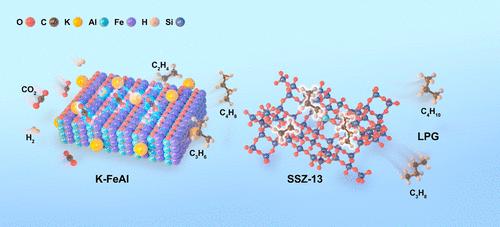Efficient Production of Liquefied Petroleum Gas from CO2 Hydrogenation by Combining Fe–Al Bimetallic Catalyst with SSZ-13 Zeolite
IF 13.1
1区 化学
Q1 CHEMISTRY, PHYSICAL
引用次数: 0
Abstract
Increasing the selectivity of target products is crucial for the CO2 hydrogenation. However, it still remains challenging for the Fe-based catalysts due to the limitation of ASF distribution. Herein, the tandem catalyst composed of Fe–Al bimetallic and the modified SSZ-13 zeolite is constructed for the efficient conversion of CO2 to liquefied petroleum gas. By balancing the CO2 adsorption and the Fe carbonization, K–2FeAl with the Fe/Al of 2 exhibits the highest CO2 conversion and light olefin selectivity. After further mixing with HSSZ-13 zeolite, the generated olefins perform cracking and hydrogenation reactions, thus concentrating the products in propane and butane. Therefore, the optimized system achieved 51.7% of liquefied petroleum gas at a CO2 conversion of 47.3%, and the space-time yield reaches 141.1 g kgcat–1 h–1, which exceeds all of the reported traditional methanol-mediated catalysts. Our work provides guidance for realizing the combination of both high reaction rates and high product selectivity in Fe-based catalysts.

铁铝双金属催化剂与SSZ-13沸石复合催化CO2加氢高效产液化石油气
提高目标产物的选择性是CO2加氢反应的关键。然而,由于ASF分布的限制,铁基催化剂仍然具有挑战性。本文构建了由Fe-Al双金属和改性SSZ-13沸石组成的串联催化剂,用于CO2高效转化为液化石油气。通过平衡CO2的吸附和Fe的碳化,Fe/Al为2的K-2FeAl表现出最高的CO2转化率和轻烯烃选择性。与HSSZ-13沸石进一步混合后,生成的烯烃发生裂化和加氢反应,从而将产物浓缩为丙烷和丁烷。因此,优化后的体系液化石油气收率达到51.7%,CO2转化率为47.3%,空时产率达到141.1 g kgcat-1 h-1,超过了目前报道的所有传统甲醇催化催化剂。本研究为铁基催化剂实现高反应速率和高产物选择性的结合提供了指导。
本文章由计算机程序翻译,如有差异,请以英文原文为准。
求助全文
约1分钟内获得全文
求助全文
来源期刊

ACS Catalysis
CHEMISTRY, PHYSICAL-
CiteScore
20.80
自引率
6.20%
发文量
1253
审稿时长
1.5 months
期刊介绍:
ACS Catalysis is an esteemed journal that publishes original research in the fields of heterogeneous catalysis, molecular catalysis, and biocatalysis. It offers broad coverage across diverse areas such as life sciences, organometallics and synthesis, photochemistry and electrochemistry, drug discovery and synthesis, materials science, environmental protection, polymer discovery and synthesis, and energy and fuels.
The scope of the journal is to showcase innovative work in various aspects of catalysis. This includes new reactions and novel synthetic approaches utilizing known catalysts, the discovery or modification of new catalysts, elucidation of catalytic mechanisms through cutting-edge investigations, practical enhancements of existing processes, as well as conceptual advances in the field. Contributions to ACS Catalysis can encompass both experimental and theoretical research focused on catalytic molecules, macromolecules, and materials that exhibit catalytic turnover.
 求助内容:
求助内容: 应助结果提醒方式:
应助结果提醒方式:


